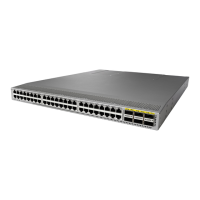CHAPTER 15
Configuring Warp SPAN
This chapter contains the following sections:
• Information About Warp SPAN, on page 167
• Guidelines and Limitations for Warp Span, on page 168
• Configuring Warp SPAN, on page 168
• Verifying Warp SPAN Mode Configuration, on page 169
• Feature History for Warp SPAN, on page 171
Information About Warp SPAN
Warp SPAN is AlgoBoost feature that spans the traffic coming into a dedicated port to a group of ports at
very low latency. In Warp SPAN, traffic arriving at one dedicated ingress port is replicated to a user configurable
group of egress ports. The packet replication happens without any filters or lookup mechanisms. Unlike normal
or Warp mode traffic forwarding, the incoming traffic is replicated before any traffic classification or ACL
processing occurs. Because traffic bypasses these processes, the latency for the replicated packets is as low
as 50ns. The Warp SPAN functions independently and simultaneously to normal traffic forwarding. For
example, the incoming source traffic can be switched, routed, multicast replicated, and so on, while at the
same time this incoming traffic is warp spanned to multiple destination ports.
The original traffic ingressing the dedicated source port is forwarded normally with nominal switch latency,
along with the Warp SPAN traffic at about 50ns to the configured destination ports. Warp SPAN can be
enabled both in normal traffic forwarding mode and Warp mode.
The source can be monitored only in the ingress direction and is not configurable. The source port is configured
automatically as soon as you configure the Warp SPAN session.
You configure the dedicated source Layer 2/Layer 3 port (must be Ethernet port 1/36) with standard
configuration as required by the network.
You configure destination ports similar to any regular SPAN destination port. The destination ports cannot
be used as regular Layer 2/Layer 3 ports. Destination ports must be configured in groups of four, so you can
create a maximum of 12 groups with a total of 47 destination ports (one port—port 1/36—is the fixed source
port). See the following table.
Table 30: Warp SPAN Groups
Destination PortsGroup
1-41
Cisco Nexus 3548 Switch NX-OS System Management Configuration Guide, Release 7.x
167

